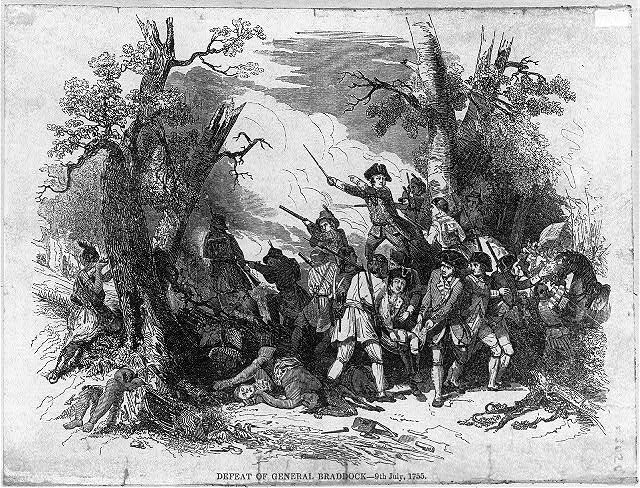
Defeat of General Braddock. Library of Congress.
How to register:
We offer two field trip scheduling options:
- Select a field trip from the Museum’s public event schedule
- Request to schedule a field-trip at a time that meets your group’s schedule
Audience:
All audiences. Content appropriate for Grades 6-12.
Goal: Learn about how the causes and effects of the French and Indian War inform our understanding of the Revolutionary War.
Program Description:
Virtual Field Trips connect students to the Museum all without leaving their desks. During this field trip, students will engage with the Army’s history through artifacts, primary sources, and Soldiers’ Stories.
Before the American Revolution, a different conflict divided the colonies and set the stage for tension between the colonies and Great Britain. Originally a land struggle between European powers, the French and Indian War provoked resentment toward Great Britain. In this virtual field trip, visitors will investigate the long-reaching effects of the French and Indian War in order to better understand its powerful relationship to the Revolutionary War.
Objective: At the end of this lesson students, will be able to
- Identify the causes of the French and Indian War.
- List the contributions of the colonists toward the conflict.
- Summarize the impacts of the French and Indian War.
- Assess how the conflicts impact on the Revolutionary War.
Guiding Questions:
How did the French and Indian War impact the Revolutionary War?
Curriculum Connections
Common Core Standards
- CCSS.ELA-LITERACY.RH.6-8.2
Determine the central ideas or information of a primary or secondary source; provide an accurate summary of the source distinct from prior knowledge or opinions.
History and Social Science Standards of Learning for Virginia Public Schools
- United States History to 1865
- USI.5 The student will apply history and social science skills to explain the social, political, religious, economic, and geographic factors that shaped colonial America by
- E) explaining the changing political and economic relationships between the colonies and Great Britain, including, but not limited to representative government and self-rule in the colonies.
- USI.6 The student will apply history and social science skills to explain the American Revolution by
- A) identifying the causes and effects of the French and Indian War;
- B) identifying the issues of dissatisfaction that led to the American Revolution, including but not limited to the “injuries and usurpation” outlined in the Declaration of Independence
- USI.5 The student will apply history and social science skills to explain the social, political, religious, economic, and geographic factors that shaped colonial America by
- Virginia and United States History
- VUS.4 The student will apply history and social science skills to analyze the cooperation and conflict between the Indigenous peoples and the new settlers by
- d) explaining the conflicts before the Revolutionary War; and
- e) describing the violent conflicts among the Indigenous peoples’ nations, including the competing claims for control of lands.
- VUS.5 The student will apply history and social science skills to understand the issues and events leading to and during the revolutionary period by
- a) describing the results of the French and Indian War;
- b) describing how political, religious, and economic ideas and interests contributed to the start of the American Revolution, including, but not limited to the resistance to imperial policy, the Stamp Act, the Townsend Acts, taxes on tea, the Coercive Acts, the Boston Tea Party, the Boston Massacre, Patrick Henry’s “Give Me Liberty, or Give Me Death” speech, the Battle of Lexington and Concord, the Battle of Bunker Hill, the Second Continental Congress and Olive Branch Petition, and Thomas Paine’s Common Sense;
- VUS.4 The student will apply history and social science skills to analyze the cooperation and conflict between the Indigenous peoples and the new settlers by
Your message has been submitted.
